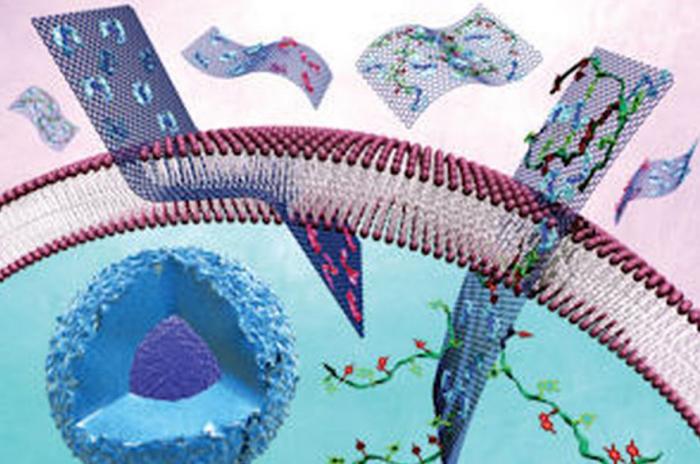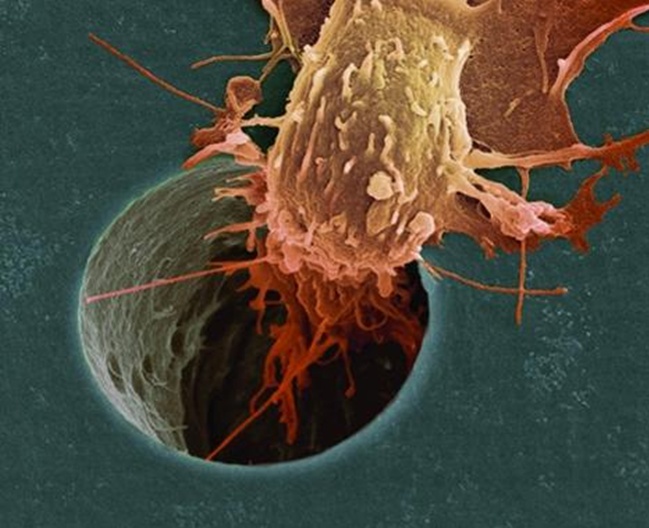Dr. Weeks Comment: Now the focus is shifting to addressing cancer STEM cells and progress is being made which bodes well – the standard fo care is shifting away from ineffective chemotherapy, radiation therapy and surgery (which only addresses cancer TUMOR cells) towards doctoring the lethal cancer STEM cells – the only cancer cells which metastasize!
“…. graphene oxide, a modified form of graphene, acts as an anti-cancer agent that selectively targets cancer stem cells (CSCs)…”
“…Cancer stem cells possess the ability to give rise to many different tumour cell types. They are responsible for the spread of cancer within the body – known as metastasis- which is responsible for 90 per cent of cancer deaths. They also play a crucial role in the recurrence of tumours after treatment. This is because conventional radiation and chemotherapies only kill the ”˜bulk’ cancer cells, but do not generally affect the CSCs…”
Graphene targets cancer stem cells
This new from development from Manchester University is claimed to open up the possibility of preventing or treating a broad range of cancers, using a non-toxic material.
Writing in Oncotarget, the team of researchers led by Prof Michael Lisanti and Dr Aravind Vijayaraghavan has shown that graphene oxide, a modified form of graphene, acts as an anti-cancer agent that selectively targets cancer stem cells (CSCs).
In combination with existing treatments, this could eventually lead to tumour shrinkage as well as preventing the spread of cancer and its recurrence after treatment. However, more pre-clinical studies and extensive clinical trials will be necessary to move this forward into the clinic to ensure patient benefit.
In a statement, Prof Lisanti, the director of the Manchester Centre for Cellular Metabolism within the University’s Institute of Cancer Sciences, said: ”˜Cancer stem cells possess the ability to give rise to many different tumour cell types. They are responsible for the spread of cancer within the body – known as metastasis- which is responsible for 90 per cent of cancer deaths.
”˜They also play a crucial role in the recurrence of tumours after treatment. This is because conventional radiation and chemotherapies only kill the ”˜bulk’ cancer cells, but do not generally affect the CSCs.’
Dr Vijayaraghavan said: ”˜Graphene oxide is stable in water and has shown potential in biomedical applications. It can readily enter or attach to the surface of cells, making it a candidate for targeted drug delivery. In this work, surprisingly, it’s the graphene oxide itself that has been shown to be an effective anti-cancer drug.
”˜Cancer stem cells differentiate to form a small mass of cells known as a tumour-sphere. We saw that the graphene oxide flakes prevented CSCs from forming these, and instead forced them to differentiate into non-cancer stem-cells.
”˜Naturally, any new discovery such as this needs to undergo extensive study and trials before emerging as a therapeutic. We hope that these exciting results in laboratory cell cultures can translate into an equally effective real-life option for cancer therapy.’
The team is said to have prepared a variety of graphene oxide formulations for testing against six different cancer types – breast, pancreatic, lung, brain, ovarian and prostate.
The flakes inhibited the formation of tumour sphere formation in all six types, suggesting that graphene oxide can be effective across all, or at least a large number of different cancers, by blocking processes which take place at the surface of the cells. The researchers suggest that, used in combination with conventional cancer treatments, this may deliver a better overall clinical outcome.
UK researchers are developing advanced graphene measurement techniques that could hasten the commercial applications of the revolutionary material. Click here to read more.
Read more: http://www.theengineer.co.uk/news/graphene-targets-cancer-stem-cells/1019937.article#ixzz3Smiq473r
AND ….
Graphene shows anticancer potential

Graphene disrupts signals on cancer stem cell membrane.
Image credit: K. Novoselov/University of Manchester
Cancer stem cells are precursor cells that can self-renew and differentiate into cancer cells and form tumors. Conventional treatments like chemotherapyand radiotherapy that wipe out the bulk of cancer cells don’t always kill cancer stem cells – a residue can survive and grow.
Residual cancer stem cells drive tumor recurrence and metastasis – where cancer spreads to other parts of the body. Metastasis is responsible for 90% of cancer deaths, so any treatment that prevents it will make a huge difference to patient survival.
Cancer stem cells are also thought to drive drug resistance, causing a significant problem for the effective treatment of cancer.
Now, a new study suggests that graphene – a nanomaterial made of extremely thin flakes of carbon that are only one atom thick – may prove to be effective in eliminating cancer stem cells.
Reporting in the journal Oncotarget, a team from the University of Manchester in the UK led by Michael Lisanti, a professor in Manchester’s Institute of Cancer Sciences – describes how graphene oxide – a modified version of graphene – selectively targeted cancer stem cells in a range of cancers.
The researchers suggest their findings open the possibility of using graphene with existing treatments not only to shrink tumors but also to prevent recurrence and metastasis.
Graphene oxide flakes prevented cancer stem cells forming tumor-spheres
The team became interested in graphene – in the form of graphene oxide – because it has shown potential as a carrier for drug delivery. The material is stable in water, and readily attaches itself to cell surfaces.
But co-author Dr. Aravind Vijayaraghavan, of Manchester’s School of Materials and National Graphene Institute, says they were surprised to find that it is the graphene oxide itself that appears to be an effective anticancer drug. He explains:
“Cancer stem cells differentiate to form a small mass of cells known as a tumor-sphere. We saw that the graphene oxide flakes prevented CSCs [cancer stem cells] from forming these, and instead forced them to differentiate into noncancer stem cells.”
However, while he and his colleagues hope these early results will lead to new cancer treatments, they also caution that there is a lot of work to do before graphene is ready for clinical trials with cancer patients.
Graphene was effective against six different cancer types
For the study, the team tested a range of graphene oxide formulations of different flake sizes on cancer stem cells from six types of cancer: breast, pancreatic, lung, brain, ovarian and prostate.
They used a method that is commonly used to test cancer stem cells, called the tumor-sphere assay or test. In the test, a tumor-sphere – a solid spherical, fused mass of cells – develops from a single cancer stem cell. Tumor spheres arising from cancer stem cells are easy to differentiate from clumps of other types of cell.
The researchers found the graphene oxide flakes prevented cancer stem cells from forming tumor-spheres across all six types of cancer, suggesting the method could work for a large range of cancers.
Further investigation revealed that graphene oxide prevents cancer stem cells from forming tumor-spheres by inhibiting several important signal pathways on the cells’ surfaces.
The team suggests the results show graphene has potential use in combination therapy, helping to boost results of conventional treatments. Co-author Dr. Federica Sotgia, also of Manchester’s Institute of Cancer Sciences, concludes:
“These findings show that graphene oxide could possibly be applied as a lavage or rinse during surgery to clear CSCs or as a drug targeted at CSCs.”
The study builds on the pioneering work of two Manchester University physicists – Andre Geim and Kostya Novoselov – who won the Nobel Prize in Physics after successfully isolating graphene from graphite in 2004.
Meanwhile, Medical News Today recently learned of another study where a team showed that camel antibodies can ferry anticancer viruses directly to tumor cells. The findings raise the hope of developing effective gene therapies that target specific cell types.
`
`


